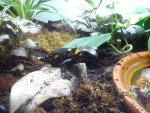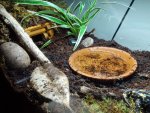Thrillbilly
New member
So I came home from work and my wife tells me that our boys found a lizard in our sandbox. She informs me that they have it in a tupperware container and askes me to see what kind it is. So I take open the lid to take a peak and see this guy with sand from the sandbox stuck to him:
![D71_0668[1].jpg D71_0668[1].jpg](https://www.caudata.org/data/attachments/30/30192-a8de292dcb4cc1031929a9f46e94a05c.jpg)
![D71_0676[1].jpg D71_0676[1].jpg](https://www.caudata.org/data/attachments/30/30193-fbf5b53fe7117919a287a14c7dfc876e.jpg)
Now I know right away that it isn't a lizard but a salamander. So I search the web to try to identify it. I couldn't find anything that looked exactly like it. However, from what I have found it looks to be some sort of tiger salamander. Armed with this info, I went out today and got a small (20gal) tank, that eco earth for substrate, sphagnum moss, some hiding areas, a lid, water dish, and a UVB 5.0 CFL bulb. I also got calcium supplement and some live cockroaches and crickets.
We put "Oscar" as my kids named him in his new habitat. He bolted to the hiding area, and then we put the live food in some of the crickets and a couple of roaches that we put the calcium on. He ate a few and then began to dig in the substrate. After a while he came back out but he looks like he has been dipped in batter. I did use a spray bottle to mist the moss down as well. I did not use tap water as I assume that the CL and other toxins are not good for them. I did not touch him during the transfer as I understand it that the oils and salts in our skin are bad for them.
So a few questions: 1. is the eco earth stuff ok and is it always going to stick to him? 2. He is pretty small around 3-4" how long will it take him to outgrow the 20gal? 3. Never having kept these before what else do I need to know?
Thanks!
![D71_0668[1].jpg D71_0668[1].jpg](https://www.caudata.org/data/attachments/30/30192-a8de292dcb4cc1031929a9f46e94a05c.jpg)
![D71_0676[1].jpg D71_0676[1].jpg](https://www.caudata.org/data/attachments/30/30193-fbf5b53fe7117919a287a14c7dfc876e.jpg)
Now I know right away that it isn't a lizard but a salamander. So I search the web to try to identify it. I couldn't find anything that looked exactly like it. However, from what I have found it looks to be some sort of tiger salamander. Armed with this info, I went out today and got a small (20gal) tank, that eco earth for substrate, sphagnum moss, some hiding areas, a lid, water dish, and a UVB 5.0 CFL bulb. I also got calcium supplement and some live cockroaches and crickets.
We put "Oscar" as my kids named him in his new habitat. He bolted to the hiding area, and then we put the live food in some of the crickets and a couple of roaches that we put the calcium on. He ate a few and then began to dig in the substrate. After a while he came back out but he looks like he has been dipped in batter. I did use a spray bottle to mist the moss down as well. I did not use tap water as I assume that the CL and other toxins are not good for them. I did not touch him during the transfer as I understand it that the oils and salts in our skin are bad for them.
So a few questions: 1. is the eco earth stuff ok and is it always going to stick to him? 2. He is pretty small around 3-4" how long will it take him to outgrow the 20gal? 3. Never having kept these before what else do I need to know?
Thanks!



